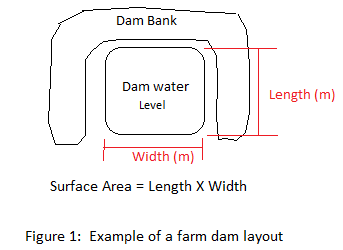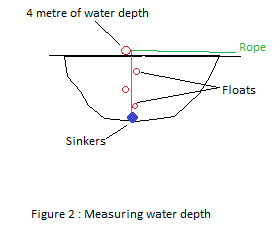How much water is left in my dam?
16 Oct 2018
Wendy Gill, Senior Land Service Officer – Mixed Farming
With the onset of spring and summer fast approaching, it is a good time to assess your enterprise farm water resources particularly ground water dams.
By now a large amount of the Central West Region’s producers have been undertaking edge or dam cleaning to either prepare dams since they have gone dry or to help make that water that is left become more accessible to livestock and last longer. This is particularly important as we head into our hotter months and livestock requirements for water increase dramatically over summer.
Following the steps shown below will allow you to work out;
- what water you have stored on farm
- expected water demands for your livestock enterprise
- if you have enough water now to sustain livestock needs over spring and summer for your enterprise
How do I measure the water left in my Dam?
Step 1: Work out your surface area of your dam.
Equipment Tools needed: a metre stick or metric tape measure.
Measure the distance of the dam length and width in metres using either 1 metre steps, a meter stick or a metric tape measure.
Using these figures multiply the length (m) by the width (m) to obtain your expected surface area for this dam.

For example: In Figure 1 we have a dam of length of 30 m and width of 40 m.
= 30 metres x 40 metres
= 1200 square metres
Step 2: Calculate how deep is your water currently in the dam (i.e Volume).
To calculate volume we use the formula;
Volume = Surface Area x Depth
Equipment/ Tools needed: length of thin rope, strong twine, fishing sinks, floats, marking pen, small cable ties and measuring tape.
Determining the volume of how much water is left in your dam can be challenging. A good method is using a line of rope or thin twine, sinkers and floats which you can purchase at your local fishing store supplier. Mark a number on each of the floats starting at 1-15 for example for the depth of the dam- ensure you have enough floats to be your markers.
Attach the sinkers to one end of the rope and at one metre intervals attach to the rope your first float with the number 1 indicated on it. Cable tie or knot the float onto the rope, measure another meter from float #1 and attach float # 2, repeat this process along the length of the rope until all floats have been tied to your rope, ensure you have some excess rope line for when you go to use this measuring floatation apparatus- you need it to be greater than width of your dam!

So at the dam’s edge on one side, place the sinker end and the coil of rope and floats, walk around the edge of the dam holding the other end of the rope, allowing the floats and rope to uncoil on the surface of the water. Once you have reached the opposite side of the dam to your starting point, slowly pull your sinker weighted end of the rope into the water. As seen in figure 2; You want to pull the rope slowly into the centre of the dam and allow the rope and the weight from the sinkers to pull the other floats under the water surface and for the sinker to settle on the bottom of the dam, so if you have a length of dam of 30 metres you will pull the sinker through to about 15 metres to the centre of the dam.
Read the number of the float that you can see on the water surface in the middle of the dam. i.e. if the float says number 4 then it tells you the depth of water in the middle of the dam is 4 metres.
Using Step 1 example and from the newly measures depth of 4 metres we can now calculate volume of water currently present in the dam.
Example cont’d: Volume = Surface Area (m) x Depth (m)
= 1200 x 4
= 4800 cubic metres
Step 3: Factor in the true volume of dams due to different shapes of dams.
Please note to take account of the shape of the dam not being square. Dams shapes can be triangle, round, circular or rectangle thus not all calculations are straight forward. To take account of weathering of dam banks and skirts from dams that were square in shape that have become more rounder multiply the volume by 0.4 to give the true volume of the dam.
Example cont’d: 4800 x 0.4 = 1920 cubic metres.
Step 4: Calculate the capacity of the water storage.
Finally, you can calculate in Mega litres (ML) the capacity of water you have in this dam on farm. This will enable you to compare what water you have as a resource for each dam you have on your property. Divide the dam’s volume of water in cubic metres by one thousand.
Example cont’d: 1920 cubic metres / 1000
= 1.92 mega litres (ML).
Repeat this process across all dam storages on farm and regularly over summer to monitor water levels on hand.
What are the water requirements of stock?
Knowing how much water your livestock consumes per day is critical in helping livestock producers plan for the upcoming heat of summer.
According to the different type of stock, stage of the animal’s growth, age or production status e.g lactating, each animal’s requirements may vary. Table 1 shows the average daily water requirements for different livestock.
Water quality is also key consideration; as water decrease the water quality can change and may cause reduced intake. Other consideration’s that effect animal’s daily intake includes water temperature, salt levels in water and seasonal conditions. In drought events where feeds ration contains a higher fibre component, this will result in increased water consumption to ensure movement of feed through the gut. During this time evaporation rates will also increase and reduce the overall water available.
How many estimated days of water do I have for my livestock operations?
Use the following deductions;
Water to supply stock (days) = Estimated total usable water (ML) / Stock water requirements per day for current stock (ML/day).
Example: a mob of 1000 dry ewes would consume an average of 6 Litres a day (refer to Table 1 above) each on grass pastures. From Step 4 example (above) we see that the dam has 1.92 ML of water left in it currently.
Water to supply stock (days) = 1.92/ 0.006
= 320 (days)
Therefore, this dam will have an estimate of approximately 320 days of water for 1000 dry ewes.
For more information:
- Primefact 326 third edition June 2014- Water requirements for Sheep and Cattle.
- Primefact 269 sixth edition August 2018-Stock taking water for livestock.
Acknowledgements:
Alastair Rayner – Rayner Ag, Tamworth
Department of Primary Industries.